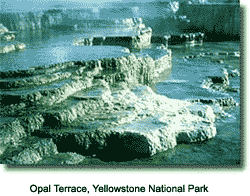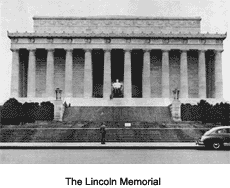"There is nothing so American as our national parks.... The fundamental idea behind the parks... is that the country belongs to the people, that it is in process of making for the enrichment of the lives of all of us."- President Franklin D. Roosevelt
National parks have been called "the best idea America ever had." The national park idea — the concept of large-scale natural preservation for public enjoyment — has been credited to the artist George Catlin, known for his paintings of American Indians in the early part of the 19th century. In 1832, while on a trip to the Dakota region, he was disturbed by the thought of the inevitable destructive effects of America's westward expansion on Indian civilization, wildlife, and wilderness. He thought they might be preserved "by some great protecting policy of government... A nation's park, containing man and beast, in all the wildness and freshness of their nature's beauty!"
During the 19th century, Americans saw nature as something to be subdued. Men came west in order to trap, hunt, and otherwise exploit the land. Later, as wagon trains began to cross the continent in mass numbers, the fragile land was feeling the effects. As the wilderness receded and portions of prehistoric civilization were lost, some began to see the need to protect examples of the nation's heritage. As time went on, appreciation for unspoiled nature grew. Spectacular natural areas in the American West were publicized, and the thought of preserving such places began to take effect.
One such spectacular natural area was Yosemite Valley. There, the "national park idea" came to partial fruition in 1864, when legislation was passed to transfer the federally owned valley, as well as the nearby Mariposa Big Tree Grove, to the state so they might "be used and preserved for the benefit of mankind." The act of Congress was signed by President Abraham Lincoln on June 30, which gave the state of California the lands, on condition that they would "be held for public use, resort, and recreation... inalienable for all time." It became a National Park on October 1, 1890.
 The geological wonders of the Yellowstone region, in the Montana and Wyoming territories, remained little known until 1868 to 1871, when expeditions traversing the area, publicized their findings. Expedition members suggested reserving Yellowstone for public use, rather than allowing it to fall under private control. Wyoming and Montana had no state governments yet to which Yellowstone could be entrusted. Therefore, Yellowstone remained in the custody of the Department of Interior — as the world's first national park.
The geological wonders of the Yellowstone region, in the Montana and Wyoming territories, remained little known until 1868 to 1871, when expeditions traversing the area, publicized their findings. Expedition members suggested reserving Yellowstone for public use, rather than allowing it to fall under private control. Wyoming and Montana had no state governments yet to which Yellowstone could be entrusted. Therefore, Yellowstone remained in the custody of the Department of Interior — as the world's first national park.
The late 19th century also saw growing interest in preserving prehistoric Indian ruins and artifacts on public lands. While the early national parks were being established, a separate movement to protect the prehistoric cliff dwellings, pueblo ruins, and early missions found on public lands in the Southwest arose. Efforts to secure protective legislation began among scientists and leaders in the 1880s and 1890s. The Antiquities Act of 1906 was a general authority for presidents to set aside "historic landmarks, historic and prehistoric structures, and other objects of historic or scientific interest" on lands owned or controlled by the United States as "national monuments." President Theodore Roosevelt took advantage of the act and proclaimed 18 national monuments by the end of his term. By the end of the century, presidents had proclaimed more than 100 national monuments.
By 1916 the Department of the Interior was responsible for 14 national parks and 21 national monuments but had no organization to manage them. To remedy this, President Woodrow Wilson approved legislation creating the National Park Service on August 25, 1916.
Through the 1920s, the National Park System dealt mostly with natural areas west of the Mississippi. This was due to the fact that the West was home to America's most spectacular natural scenery, and most of the land there was federally owned and subject to park or monument reservation without purchase.
 In order for the system to benefit more people, however, it became imperative that expansion move eastward as well. In 1926, Congress authorized Shenandoah, Mammoth Cave, and Great Smoky Mountains national parks in the Appalachian region. The system also established many new historical parks in the East, which held a great number of battlefields, forts, and memorials, preserved through the auspices of the War Department. President Franklin D. Roosevelt ordered all military parks transfered to the Park Service, which received 15 national monuments, national capital parks, including the Lincoln Memorial and White House, and nearly 40 historical areas in the East.
In order for the system to benefit more people, however, it became imperative that expansion move eastward as well. In 1926, Congress authorized Shenandoah, Mammoth Cave, and Great Smoky Mountains national parks in the Appalachian region. The system also established many new historical parks in the East, which held a great number of battlefields, forts, and memorials, preserved through the auspices of the War Department. President Franklin D. Roosevelt ordered all military parks transfered to the Park Service, which received 15 national monuments, national capital parks, including the Lincoln Memorial and White House, and nearly 40 historical areas in the East.
During the 1930s, the Park Service became involved with areas intended primarily for mass recreation, including parkways and waterways. Since 1933, other parks and monuments have been placed under the jurisdiction of the National Park Service, including National Seashores, National Recreation Areas, and National Lakeshores.
The National Historic Preservation Act of 1966 authorized the bureau to maintain a comprehensive National Register of Historic Places, which has become America's official list of cultural properties worthy of preservation. Those properties, whether publicly or privately owned, and locally and nationally significant, receive special consideration in federal project planning, federal grants, and technical assistance.
During the 1960s, several new types of parks joined the system. Ozark National Scenic Riverways in Missouri, which was authorized by Congress in 1964, foreshadowed the Wild and Scenic Rivers Act of 1968. The first national lakeshores were also introduced, as well as the National Trails Systems Act of 1968, which made the Park Service responsible for the Appalachian National Scenic Trail. The trail runs more than 2,100 miles from Maine to Georgia, traversing 14 states.
The Alaska National Interest Lands Conservation Act of 1980 more than doubled the size of the national park system, by adding more than 47 million wilderness acres. The Wrangell-St. Elias National Park comprises more than 8,300,000 acres, while the Wrangell-St. Elias National Preserve consists of nearly 4,900,000.
The National Park Service System now includes 423 areas, covering more than 85 million acres, in nearly every state and U.S. possession. The Park Service supports the preservation of natural and historic places as well as promotes outdoor recreation outside the system through grant and technical assistance.